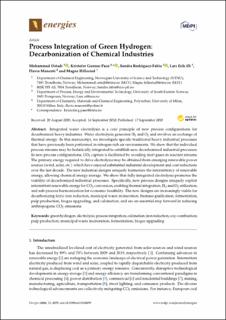| dc.contributor.author | Ostadi, Mohammad | |
| dc.contributor.author | Paso, Kristofer Gunnar | |
| dc.contributor.author | Rodriguez-Fabia, Sandra | |
| dc.contributor.author | Øi, Lars Erik | |
| dc.contributor.author | Manenti, Flavio | |
| dc.contributor.author | Hillestad, Magne | |
| dc.date.accessioned | 2020-10-02T12:35:13Z | |
| dc.date.available | 2020-10-02T12:35:13Z | |
| dc.date.created | 2020-09-17T11:31:59Z | |
| dc.date.issued | 2020 | |
| dc.identifier.citation | Ostadi, M., Paso, K. G., Rodriguez-Fabia, S., Øi, L. E., Manenti, F., & Hillestad, M. (2020). Process Integration of Green Hydrogen: Decarbonization of Chemical Industries. Energies, 13(18), 4859. | en_US |
| dc.identifier.issn | 1996-1073 | |
| dc.identifier.uri | https://hdl.handle.net/11250/2680964 | |
| dc.description.abstract | Integrated water electrolysis is a core principle of new process configurations for decarbonized heavy industries. Water electrolysis generates H2 and O2 and involves an exchange of thermal energy. In this manuscript, we investigate specific traditional heavy industrial processes that have previously been performed in nitrogen-rich air environments. We show that the individual process streams may be holistically integrated to establish new decarbonized industrial processes. In new process configurations, CO2 capture is facilitated by avoiding inert gases in reactant streams. The primary energy required to drive electrolysis may be obtained from emerging renewable power sources (wind, solar, etc.) which have enjoyed substantial industrial development and cost reductions over the last decade. The new industrial designs uniquely harmonize the intermittency of renewable energy, allowing chemical energy storage. We show that fully integrated electrolysis promotes the viability of decarbonized industrial processes. Specifically, new process designs uniquely exploit intermittent renewable energy for CO2 conversion, enabling thermal integration, H2 and O2 utilization, and sub-process harmonization for economic feasibility. The new designs are increasingly viable for decarbonizing ferric iron reduction, municipal waste incineration, biomass gasification, fermentation, pulp production, biogas upgrading, and calcination, and are an essential step forward in reducing anthropogenic CO2 emissions. | en_US |
| dc.language.iso | eng | en_US |
| dc.rights | Navngivelse 4.0 Internasjonal | * |
| dc.rights.uri | http://creativecommons.org/licenses/by/4.0/deed.no | * |
| dc.title | Process Integration of Green Hydrogen: Decarbonization of Chemical Industries | en_US |
| dc.type | Peer reviewed | en_US |
| dc.type | Journal article | en_US |
| dc.description.version | publishedVersion | en_US |
| dc.rights.holder | © 2020 by the authors. | en_US |
| dc.source.journal | Energies | en_US |
| dc.identifier.doi | https://doi.org/10.3390/en13184859 | |
| dc.identifier.cristin | 1830769 | |
| cristin.ispublished | true | |
| cristin.fulltext | original | |
| cristin.qualitycode | 1 | |

